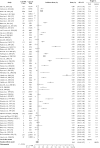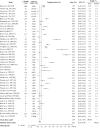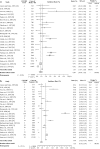Systematic review and meta-analysis of the prevalence of chronic fatigue syndrome/myalgic encephalomyelitis (CFS/ME)
- PMID: 32093722
- PMCID: PMC7038594
- DOI: 10.1186/s12967-020-02269-0
Systematic review and meta-analysis of the prevalence of chronic fatigue syndrome/myalgic encephalomyelitis (CFS/ME)
Abstract
Background: Chronic fatigue syndrome/myalgic encephalomyelitis (CFS/ME) has been emerging as a significant health issue worldwide. This study aimed to systemically assess the prevalence of CFS/ME in various aspects of analyses for precise assessment.
Methods: We systematically searched prevalence of CFS/ME from public databases from 1980 to December 2018. Data were extracted according to 7 categories for analysis: study participants, gender and age of the participants, case definition, diagnostic method, publication year, and country of the study conducted. Prevalence data were collected and counted individually for studies adopted various case definitions. We analyzed and estimated prevalence rates in various angles: average prevalence, pooled prevalence and meta-analysis of all studies.
Results: A total of 1291 articles were initially identified, and 45 articles (46 studies, 56 prevalence data) were selected for this study. Total 1085,976 participants were enrolled from community-based survey (540,901) and primary care sites (545,075). The total average prevalence was 1.40 ± 1.57%, pooled prevalence 0.39%, and meta-analysis 0.68% [95% CI 0.48-0.97]. The prevalence rates were varied by enrolled participants (gender, study participants, and population group), case definitions and diagnostic methods. For example, in the meta-analysis; women (1.36% [95% CI 0.48-0.97]) vs. men (0.86% [95% CI 0.48-0.97]), community-based samples (0.76% [95% CI 0.53-1.10]) vs. primary care sites (0.63% [95% CI 0.37-1.10]), adults ≥ 18 years (0.65% [95% CI 0.43-0.99]) vs. children and adolescents < 18 years (0.55% [95% CI 0.22-1.35]), CDC-1994 (0.89% [95% CI 0.60-1.33]) vs. Holmes (0.17% [95% CI 0.06-0.49]), and interviews (1.14% [95% CI 0.76-1.72]) vs. physician diagnosis (0.09% [95% CI 0.05-0.13]), respectively.
Conclusions: This study comprehensively estimated the prevalence of CFS/ME; 0.89% according to the most commonly used case definition CDC-1994, with women approximately 1.5 to 2 folds higher than men in all categories. However, we observed the prevalence rates are widely varied particularly by case definitions and diagnostic methods. An objective diagnostic tool is urgently required for rigorous assessment of the prevalence of CFS/ME.
Keywords: CFS; Chronic fatigue syndrome; ME/CFS; Meta-analysis; Prevalence; Systematic review.
Conflict of interest statement
There are no potential conflicts of interest to disclose.
Figures





Similar articles
-
Prevalence of myalgic encephalomyelitis/chronic fatigue syndrome (ME/CFS) in three regions of England: a repeated cross-sectional study in primary care.BMC Med. 2011 Jul 28;9:91. doi: 10.1186/1741-7015-9-91. BMC Med. 2011. PMID: 21794183 Free PMC article.
-
Prevalence of myalgic encephalomyelitis/chronic fatigue syndrome (ME/CFS) in Australian primary care patients: only part of the story?BMC Public Health. 2022 Aug 9;22(1):1516. doi: 10.1186/s12889-022-13929-9. BMC Public Health. 2022. PMID: 35945527 Free PMC article.
-
Myalgic Encephalomyelitis/Chronic Fatigue Syndrome After SARS-CoV-2 Infection.JAMA Netw Open. 2024 Jul 1;7(7):e2423555. doi: 10.1001/jamanetworkopen.2024.23555. JAMA Netw Open. 2024. PMID: 39046739 Free PMC article.
-
Systematic review of fatigue severity in ME/CFS patients: insights from randomized controlled trials.J Transl Med. 2024 Jun 3;22(1):529. doi: 10.1186/s12967-024-05349-7. J Transl Med. 2024. PMID: 38831460 Free PMC article.
-
Review of case definitions for myalgic encephalomyelitis/chronic fatigue syndrome (ME/CFS).J Transl Med. 2020 Jul 29;18(1):289. doi: 10.1186/s12967-020-02455-0. J Transl Med. 2020. PMID: 32727489 Free PMC article. Review.
Cited by
-
Severe myalgic encephalomyelitis/chronic fatigue syndrome in children and young people: a British Paediatric Surveillance Unit study.Arch Dis Child. 2023 Mar;108(3):230-235. doi: 10.1136/archdischild-2022-324319. Epub 2022 Dec 1. Arch Dis Child. 2023. PMID: 36456114 Free PMC article.
-
The maintained attention assessment in patients affected by Myalgic encephalomyelitis/chronic fatigue syndrome: a reliable biomarker?J Transl Med. 2021 Dec 4;19(1):494. doi: 10.1186/s12967-021-03153-1. J Transl Med. 2021. PMID: 34863209 Free PMC article.
-
Nationwide epidemiological characteristics of chronic fatigue syndrome in South Korea.J Transl Med. 2021 Dec 7;19(1):502. doi: 10.1186/s12967-021-03170-0. J Transl Med. 2021. PMID: 34876158 Free PMC article.
-
Commonalities in the Features of Cancer and Chronic Fatigue Syndrome (CFS): Evidence for Stress-Induced Phenotype Instability?Int J Mol Sci. 2022 Jan 8;23(2):691. doi: 10.3390/ijms23020691. Int J Mol Sci. 2022. PMID: 35054876 Free PMC article. Review.
-
A preliminary investigation of nutritional intake and supplement use in Australians with myalgic encephalomyelitis/chronic fatigue syndrome and the implications on health-related quality of life.Food Nutr Res. 2021 Jun 7;65. doi: 10.29219/fnr.v65.5730. eCollection 2021. Food Nutr Res. 2021. PMID: 34262415 Free PMC article.
References
-
- National Institutes of Health. ME/CFS. About ME/CFS. 2017 February 6, 2017 [cited 2019 July, 24th]. https://www.nih.gov/mecfs/about-mecfs.
-
- Institute of medicine of the national academes, Beyond myalgic encephalomyelitis/chronic fatigue syndrome; Redefining an illness, Committee on the diagnostic criteria for ME/CFS, 2015, Institute of medicine: Washington, D.C.
-
- Castro-Marrero J, Faro M, Zaragoza MC, Aliste L, de Sevilla TF, Alegre J. Unemployment and work disability in individuals with chronic fatigue syndrome/myalgic encephalomyelitis: a community-based cross-sectional study from Spain. BMC Public Health. 2019;19(1):840. doi: 10.1186/s12889-019-7225-z. - DOI - PMC - PubMed
Publication types
MeSH terms
LinkOut - more resources
Full Text Sources
Medical

